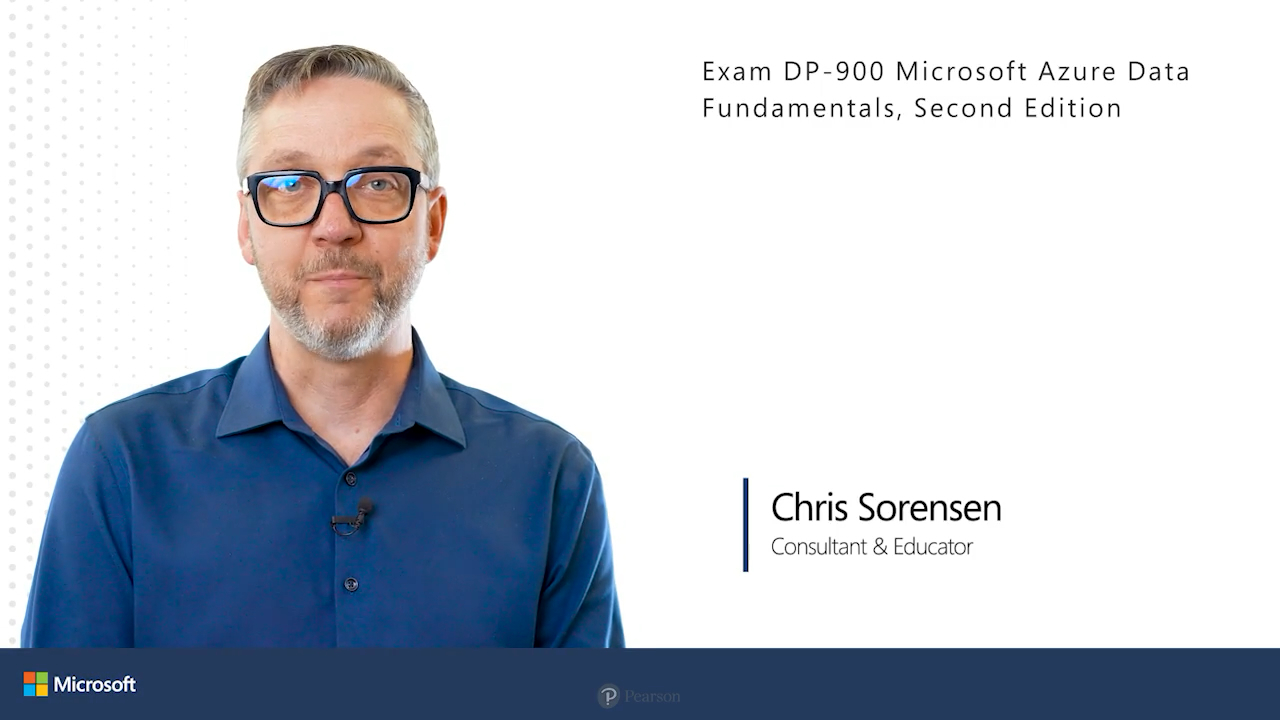Exam DP-900: Microsoft Azure Data Fundamentals, Second Edition (Video), 2nd Edition
- By Chris Sorensen
- Published Jul 17, 2024 by Microsoft Press.
Online Video
- Your Price: $159.99
- List Price: $199.99
- About this video
Video accessible from your Account page after purchase.
Register your product to gain access to bonus material or receive a coupon.
Description
- Copyright 2025
- Edition: 2nd
- Online Video
- ISBN-10: 0-13-535300-9
- ISBN-13: 978-0-13-535300-4
3+ Hours of Video Instruction
Prepare for Microsoft Exam DP-900 and demonstrate your knowledge of fundamental data concepts and Microsoft Azure data services.
This Exam DP-900 Microsoft Azure Data Fundamentals video is designed to help you begin to work with data in the cloud. This video focuses on the skills measured by the exam objectives, as updated by Microsoft in February 2024.
- Describe core data concepts
- Identify considerations for relational data on Azure
- Describe considerations for working with non-relational data on Azure
- Describe an analytics workload on Azure
Using his years of experience working with data and teaching data best practices to a variety of learners, Microsoft Certified Trainer Chris Sorensen explains core concepts related to working with data in Azure. In his engaging style grounded in real-world scenarios, Chris gives you insights to relational and non-relational data, different types of workloads, and analytical best practices. With Chris as your guide, you are well-equipped to successfully attempt the DP-900 exam and advance in your career as a data engineer or database administrator.
Skill Level
- Beginner to Intermediate
Who Should Take This Course
- Certification candidates preparing for exam DP-900 Microsoft Azure Data Fundamentals
- Analysts or admins beginning to work with data in the cloud
Course Requirements
- Foundational knowledge of core data concepts
Sample Content
Table of Contents
Introduction
Module 1: Describe core data concepts
Lesson 1: Describe ways to represent data
Learning objectives
1.1 Describe features of structured data
1.2 Describe features of semi-structured data
1.3 Describe features of unstructured data
Lesson 2: Identify options for data storage
Learning objectives
2.1 Describe common formats for data files
2.2 Describe types of databases
Lesson 3: Describe common data workloads
Learning objectives
3.1 Describe features of transactional workloads
3.2 Describe features of analytical workloads
Lesson 4: Identify roles and responsibilities for data workloads
Learning objectives
4.1 Describe responsibilities for database administrators
4.2 Describe responsibilities for data engineers
4.3 Describe responsibilities for data analysts
Module 2: Identify considerations for relational data on Azure
Lesson 5: Describe relational concepts
Learning objectives
5.1 Identify features of relational data
5.2 Describe normalization and why it is used
5.3 Identify common structured query language (SQL) statements
5.4 Identify common database objects
Lesson 6: Describe relational Azure data services
Learning objectives
6.1 Describe the Azure SQL family of products including Azure SQL Database, Azure SQL Managed Instance, and SQL Server on Azure Virtual Machines
6.2 Identify Azure database services for open-source database systems
Module 3: Describe considerations for working with non-relational data on Azure
Lesson 7: Describe capabilities of Azure storage
Learning objectives
7.1 Describe Azure Blob storage
7.2 Describe Azure File storage
7.3 Describe Azure Table storage
Lesson 8: Describe capabilities and features of Azure Cosmos DB
Learning objectives
8.1 Identify use cases for Azure Cosmos DB
8.2 Describe Azure Cosmos DB APIs
Module 4: Describe an analytics workload on Azure
Lesson 9: Describe common elements of large-scale analytics
Learning objectives
9.1 Describe considerations for data ingestion and processing
9.2 Describe options for analytical data stores
9.3 Describe Azure services for data warehousing, including Azure Synapse Analytics, Azure Databricks, Microsoft Fabric, Azure HDInsight, and Azure Data Factory
Lesson 10: Describe consideration for real-time data analytics
Learning objectives
10.1 Describe the difference between batch and streaming data
10.2 Identify Microsoft cloud services for real-time analytics
Lesson 11: Describe data visualization in Microsoft Power BI
Learning objectives
11.1 Identify capabilities of Power BI
11.2 Describe features of data models in Power BI
11.3 Identify appropriate visualizations for data
Summary
